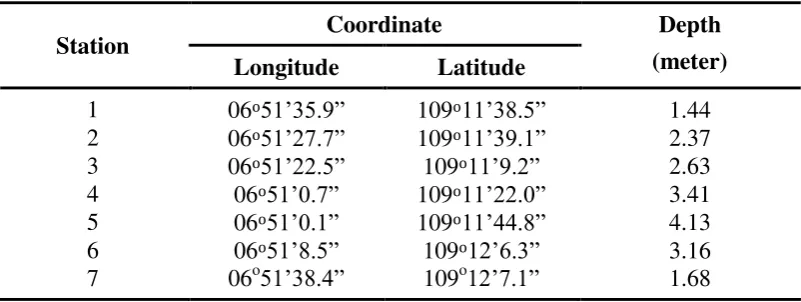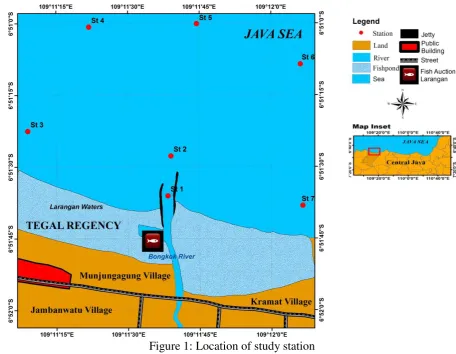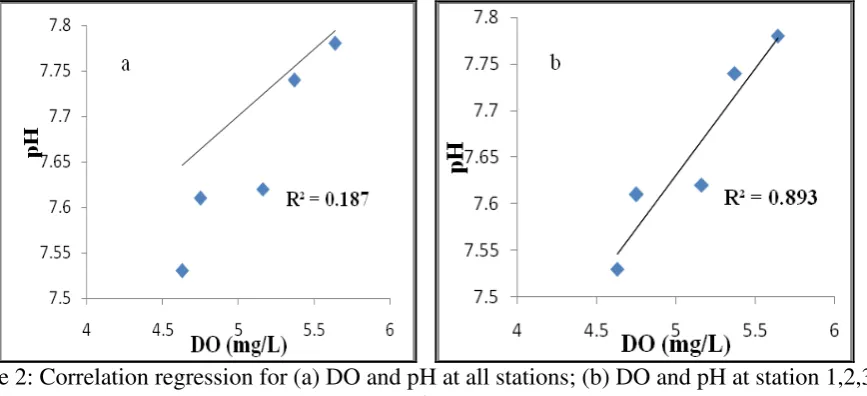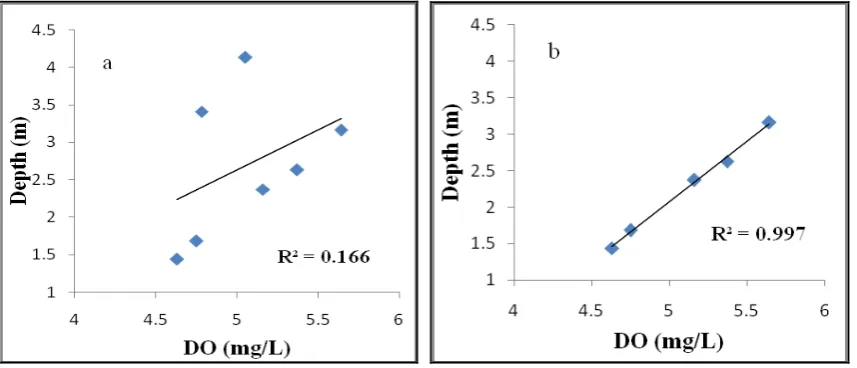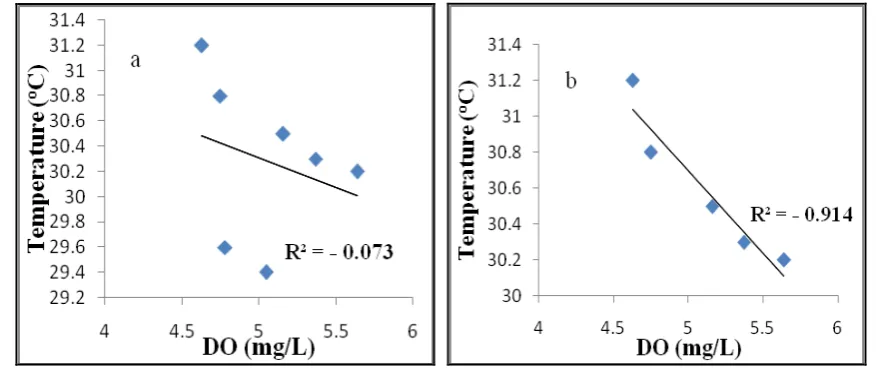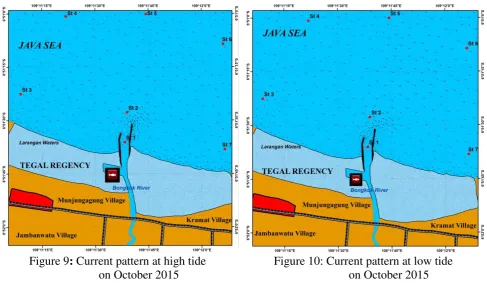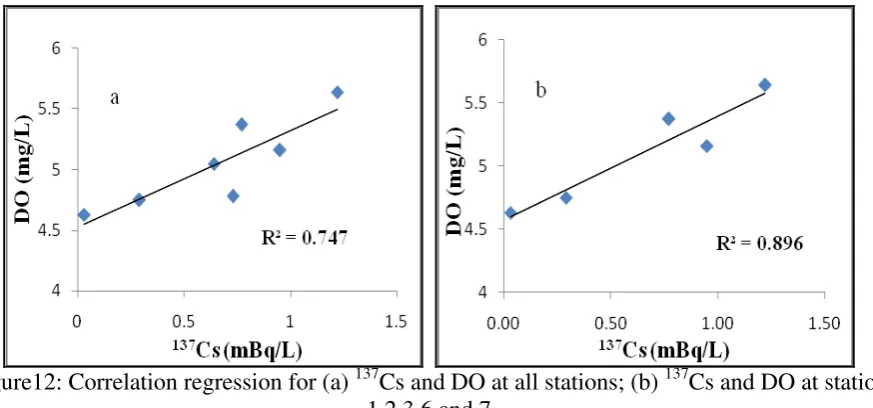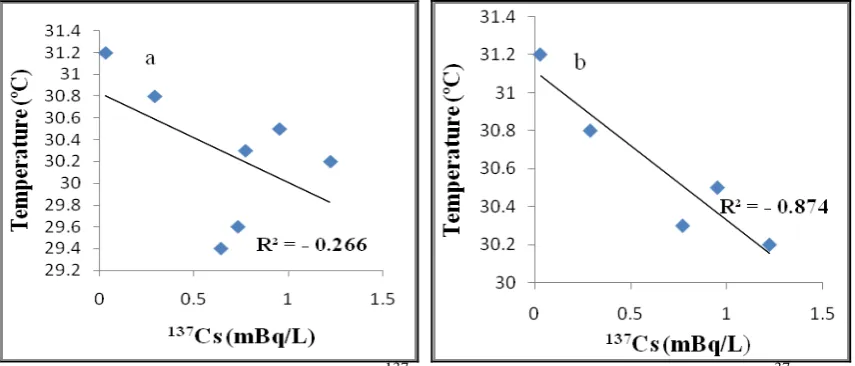RELATIVE EFFECT OF WATER QUALITY ON 137Cs ACTIVITY IN LARANGAN WATER, TEGAL
Muslim1, Wahyu Retno Prihatiningsih2 and Adi Budi Nugroho1
1
Oceanography Study Program, Diponegoro University, Semarang, 50275 Indonesia 2
Marine Radioecology Group, Center for Radiation Safety Technology and Metrology - National Nuclear Energy Agency, Jl. Lebak Bulus Raya No. 49, Kotak Pos 7043 JKSKL Jakarta Selatan,
12070 Indonesia
Correspondence author: [email protected] and [email protected]
ABSTRACT
Tegal is a city in Central Java experiencing rapid industrial development. The Larangan waters of Tegal receive household, agricultural, and industrial waste that flows directly into the Bongkok River. The purpose of this study was to determine the relative effects of water quality on 137Cs activity. We found that this wastewater has caused a decline in dissolved oxygen (DO), pH and salinity and an increase in water temperature. Current velocity and water depth increased with distance from the mouth of the river and affected the correlation regression between the water quality parameters. The correlation regression becomes stronger in waters that were affected by the land waste and was very weak at stations 4 and 5, which were not strongly influenced by the waste from the land. The correlation regression between 137Cs activity in the coastal waters under the influence of land showed a strong correlation with several water quality parameters such as DO, pH, temperature, as well as current velocity and water depth.
Keywords: 137Cs, Larangan waters, relative effect,waste, water quality,
INTRODUCTION
An accident such as the one from Nuclear Power Plant (NPP) Fukushima on March 11, 2011, has pushed nuclear experts in the world to improve nuclear research activities in the sea. Some of the radioactive elements of concern are 137Cs, 90Sr, and 241Am. 137Cs is the most abundant anthropogenic radionuclide in the marine environment and has a half-life of 30.17 years. Its conservative nature means that the element is soluble, and is therefore easily distributed, but also can be deposited with the influence of other factors including particle size and mineral content of chemicals such as organic material (Muslim et al., 2015).
Coastal and estuarine waters are the most productive aquatic systems (Pereira - Filho et al., 2001) suitable for spawning, growth, breeding and protective areas for a wide variety of fish, mollusks, crustaceans, birds and mammals (Ohrel and Register, 2006). Estuaries also support fisheries, transportation, and tourism, and are natural buffers between land and sea. In Indonesia, today, increasing pollution from industrial and agricultural waste are discharged into estuarine waters (Sri et al., 2014). The marine environment is also a major recipient of anthropogenic global radionuclide fallout from testing of nuclear weapons by the US and the USSR in the 1960s, nuclear accidents and waste disposal from Nuclear Power Plants (Povinec et al., 2003a; UNSCEAR, 2000).
46
It is already evident that urbanization and industrialization has a great and direct influence on the rate of change of sedimentation in coastal areas (Lu and Matsumoto, 2005).
Chemical constituents in coastal or estuarine waters can be controlled by physical influences within or outside the water (Jones et al., 2002). Organic materials in the ocean that can affect the level of adsorption of chemicals (eg. 137Cs), are influenced by several factors such as currents, depth of water and particle size (Arzayus et al., 2002; Kristensen and Blackburn, 1987; Muslim et al., 2015; Sun et al., 2002). Dissolution easily occurs in shallow estuarine and coastal areas due to physical and biological processes (Dellapenna et al., 1998; Hopkinson, 1985). Differences in environmental conditions cause regional differences in the biogeochemistry of the decomposition of organic matter.
Estuarine environments are generally located at a river mouth that empties into the sea (Elliott and McLusky, 2002). Therefore, estuarine mixing incorporates both saline and fresh water, assisted by wind movement. The flow of sea water is influenced by tidal currents, while the fresh water comes from the river (Priya et al., 2012). Changes in water level and mixing in estuarine environments during low tide as well as in the monsoon season affects water quality measurements including total suspended solids (Chen et al., 2006; Spellman, 2011), dissolved oxygen (Perkins, 1974), water temperature (Olausson and Cato, 1980), salinity (Ohrel and Register, 2006; Prasanna and Ranjan, 2010), pH (Spellman, 2011), conductivity (Smith, 1992), light intensity (Dennison et al., 1993), brightness (Borja and Collins, 2004; Wangersky, 2006), surface and bottom currents (Kramer et al., 1994), nitrogen (Kennish, 2002; Neil, 2005), phosphate (Van der Zee et al., 2007) and the concentration of chlorophyll a (Conley et al., 2000; Muslim and Jones, 2003; Zheng et al., 2004) that will affect the biomass and species composition of phytoplankton (Aquino et al., 2015; Canini et al., 2013; Domingues et al., 2010;.Lauria et al., 1999)
47 MATERIALS AND METHODS
Determination of Research Station
Seven stations were chosen with attention to the circumstances of each station including depth and distance from the Bongkok River estuary. The coordinates of each station were determined by GPS (Global Positioning System). Stations 1 and 2 are located in the breakwater area that gets the direct influence of the river and has a water depth < 2.5 m, stations 3 and 7 are in the region close to the Larangan beach with a depth < 3 m. Stations 4, 5 and 6 located far away from the coast or into the open sea with a depth > 3 m. Coordinates of the location of each station are shown in Table 1 and Figure 1.
Surface sea water for 137Cs analysis was collected using 30 L polyethylene buckets that were rinsed at least twice with surface seawater and then were poured into a 100 L plastic bucket until the 90 L mark. We immediately added K4[Fe(CN)6] and CuSO4 (10 grams each) to the water samples, which binds 137Cs in a water sample. In order for the binding to be completed, the water sample was stirred then allowed to stand until a precipitate containing 137Cs formed. Clearwater above the sediment was removed by vacuuming with a plastic hose, and the precipitates were collected in a 5 L bucket and taken to the laboratory. While sampling, we were also measured water quality i.e. salinity, temperature, dissolved oxygen (DO), pH and water depth.
Current Modeling
48
Figure 1: Location of study station
Preparation and Measurement 137Cs in the Laboratory
At the laboratory, samples in the 5 L buckets were filtered with filter paper to separate the precipitates from the water. The precipitates were then oven-dried at 70 - 80oC for about 3 days. The dried precipitates were then put in a plastic container for the measurement (counting) using Gamma Spectrometer for 3 days (IAEA, 2005).
RESULTS AND DISCUSSION
Water Quality Parameters
49
Table 2: Water quality in Larangan waters, Tegal
Station Environmental Parameter
Figure 1 shows that the station 4 and 5 are closest to the open sea and had the deepest water depths of 3.41 m and 4.13 m, respectively. These conditions were affected the water quality i.e. pH which was the highest at these sites (7.82 and 7.86). Stations 4 and 5 were far from the river mouth and have low organic matter content, therefore, the concentration of carbon and nutrients are reduced (Ferrari, 2000). Consequently, the pH rises, indicating the water is more alkaline as well as less influenced by the organic material from the river, which influences pH, creating an alkaline pH (Schulz et al., 2006).
The salinity at stations 4 and 5 was relatively high despite the low temperatures, because the fresh water from the river does not affect stations 4 and 5, and the level of evaporation was greater than near the coastline (Prasanna and Ranjan, 2010).
The above conditions affect the correlation regression between parameters of water quality, where the correlation between the parameters was weak for stations 4 and 5, or the correlation regression between the parameters of the water quality becomes more significant if tested on waters still heavily influenced from the mainland (terrestrial runoff) such as in stations 1, 2, 3, 6 and 7. The correlation regression between water quality parameters in all stations and excluding stations 4 and 5 can be seen in Figures 2, 3, 4, 5, 6, 7 and 8.
50
Figure 3: Correlation regression for (a) DO and depth at all stations; (b) DO and depth at station 1,2,3,6 and 7
Figure 4: Correlation regression for (a) DO and current velocity at all stations; (b) DO and current velocity at station 1,2,3,6 and 7
51
Figure 6: Correlation regression for (a) DO and temperature at all stations; (b) DO and temperature at station 1,2,3,6 and 7
Figure 7: Correlation regression for (a) pH and depth at all stations; (b) pH and depth at station 1,2,3,6 and 7
52
Oxidation of organic materials that consume oxygen in addition to reducing DO also reduces the pH (Marion et al., 2011). In this study, the correlation regression between DO and pH occurs well in areas that are still affected by the wastewater (Figure 2b; R2 = 0.893). However, the correlation regression will be weaker when we include stations 4 and 5, which are not very influenced by the wastewater runoff (Figure 2a; R2= 0.187). This shows that the mainland waste (organic waste) affects DO and pH. According to Muslim (2010; 2013) the increase in organic matter in the water is proportional to the increase in the value of COD, (Chemical Oxygen Demand) therefore reducing the dissolved oxygen (DO) content and pH.
Figure 3b shows that the DO also has a strong positive correlation with depth (R²= 0.997) at stations that are influenced by the mainland. According to Chen et al., (2016) the oxidation process of organic material occurs at the bottom of the water so that surface water in deeper areas (stations 4 and 5) has a higher DO content, due to the low oxidation of organic materials and photosynthesis producing an oxygen-rich layer higher in the water column. In addition to increasing DO, pH also increases with increasing depths of water. According to Ahmat et al. (2016), the correlation regression depends on environmental conditions, especially the slope of land sediment. In this study, increasing the water depth and distance from the source of waste (organic) shows that DO is also positively associated with the current velocity (Figure 4).
Figure 6 also shows that the DO has a strong negative correlation with temperature, because temperature decreases with increasing distance from the mainland, while DO increases with distance from the mainland (Tao et al., 2016). Therefore, there is a relationship between the water quality parameters above.
The concentration of salinity in waters is heavily influenced by several factors, such as the flow of fresh water from rivers, evaporation, topography and vegetation distribution (Humphries et al., 2010). The correlation regression between salinity and DO is weakly positive (R2 = 0.08 and R2 = 0.409) (Figure 5). Pavlov et al. (2016) found a strong correlation regression between salinity and oxygen (R2 = 0.96, n = 162) in an area with freshwater inputs from the mainland. Kim et al. (2016) and Chen et al. (2016) found a negative relationship between salinity with some organic materials from the land, spreading from Changjiang River to the East China Sea. If oxidation of organic matter occurs, the DO concentration will decrease; therefore, DO shows a positive correlation with salinity.
The relative effect also occurred in regards to pH, where pH has a strong positive correlation with depth (Figure 7). The depth increases and temperature decrease with distance from the estuary. Therefore, the pH also has a relatively strong association with temperature (Figure 8).
Current Patterns
53 Figure 9: Current pattern at high tide
on October 2015
Figure 10: Current pattern at low tide on October 2015
137
Cs Activity in the Larangan Waters Tegal
137
Cs activity in the Larangan waters, Tegal was detected with values ranging between 0.03 to 1.22 mBq/L, and an average value of 0.58 mBq/L (Table 3). This value is lower than previous research in Sayung waters, Demak in October 2014, with an average value of 0.86 mBq/L (Muslim et al., In press) and higher than in Gresik waters tested in September 2013 with a value of 0.200 mBq/L (Muslim et al., 2015). The difference is due to different water conditions that 137Cs in water are heavily influenced by factors such as current pattern and ion exchange with other elements such as organic matter and sulfur (Muslim et al., 2015).
Table 3: Analysis result of 137Cs in sea water
Station 137Cs (mBq/L)
Depth (m)
Current (m/s)
1 0.03 1.44 0.0012
2 0.95 2.37 0.0487
3 0.77 2.63 0.0299
4 0.73 3.41 0.0456
5 0.64 4.13 0.0609
6 1.22 3.16 0.0617
7 0.29 1.68 0.0211
54
Table 3 shows that the highest 137Cs activity (1.22 mBq/L) and current velocity (0.0617 m/sec) at station 6. While the lowest occurred in station 1 for 137Cs (0.03 mBq/L) and for current velocity ( 0.0012 m/sec). Correlation between current velocity and 137Cs activity at all stations is positively correlated R²= 0.752 (Figure 11) and even stronger when the correlation was tested at station 1, 2, 3, 6 and 7 (R²= 0.880). This shows that the 137Cs activity levels are affected by the current velocity, because according to Povinec et al. (2003b) the radionuclides in water can be affected by advection, dispersion, and precipitation.
Figure 11: Correlation regression for (a) 137Cs and current velocity at all stations; (b) 137Cs and current velocity at station 1,2,3,6 and 7
Based on the water quality conditions above, the relative correlation occurs between the activity of 137
Cs with water quality parameters as shown in Figures 12, 13, 14, 15 and 16.
Figure12: Correlation regression for (a) 137Cs and DO at all stations; (b) 137Cs and DO at station 1,2,3,6 and 7
55
matter and settles to the bottom (Van Bergeijk et al., 1992). Therefore, more organic material reduces the degradation time for 137Cs and DO in the water.
Figure13: Correlation regression for (a) 137Cs and depth at all stations; (b) 137Cs and depth at station 1,2,3,6 and 7
Organic materials sourced from the mainland decreased with distance from the source. This research shows that the further away from the mainland, the water also becomes deeper. Under these conditions, the DO and 137Cs activity have a strong correlation with water depth (Figure 13), with R2= 0.921 at the stations under the influence of the organic material.
pH has a strong positive correlation (R2= 0.893) with DO (Figure 2) at stations that are affected by the wastewater (organic). DO and pH also affects the correlation between137Cs activity and pH (Figure 14). Rahman and Voigt (2004) found that increasing 137Cs with an increase in pH and K content of sediment (soil potassium).
56
The variation of salinity is due to many factors, so the correlation regression between DO and salinity was not very strong with an R2 = 0.080 and R2 = 0.409 (Figure 5). This resulted in the correlation regression between 137Cs activity with salinity becoming stronger as shown in Figure 15.
Figure 15: Correlation regression for (a) 137Cs and salinity at all stations; (b) 137Cs and salinity at station 1,2,3,6 and 7
The distribution of temperature in the Larangan waters Tegal decreases with distance from the mainland. The DO concentration, as opposed to temperature, increased with distance from the mainland. The conditions also affect the correlation between 137Cs activity and temperature (Figure 16), which has a negative correlation (R2 = - 0.874) to stations that are still affected by the waste organic materials from the mainland.
Figure 16: Correlation regression for (a) 137Cs and temperature at all stations; (b) 37Cs and temperature at station 1,2,3,6 and 7
CONCLUSIONS
57
weakest current velocity and the highest water temperature. Station 1 also has the lowest pH, DO, and salinity. The low DO at station 1 is due to the decomposition of organic material, there is the highest organic material at this station compared to other stations. The result shows the strong correlated regression between the water quality parameters at other stations (1,2,3,6 and 7) without station 4 and 5that both stations are not very affected by waste from the mainland. The water quality also influenced the correlation regression with 137Cs activity. The lowest 137Cs activity recorded at station 1 because high content of organic material in waste at station 1. The high 137Cs activity found at stations 4 and 5 due to small input of mainland waste. The correlation regression between water quality and 137Cs activity was also strong correlated when this regression analysis was test at 5 stations without station 4 and 5.
ACKNOWLEDGEMENTS
We would like to thank Dr. Henny Suseno and his colleague in Marine Radioecology laboratory for their collaboration in the samples preparation and counting of 137Cs activity. Special thanks to Adi Prasojo for helping in samples collecting. Thank very much to Susie Vulpas for comments this paper and correcting the English.
REFERENCES
Ahmat, M.A., Boussafi, M., Le Milbeau, C., Guegan, R., Valdès, J., Guiñez, M., Sifeddine, A. and Le Forestier, L. (2016). Organic matter-clay interaction along a seawater column of the Eastern Pacific upwelling system (Antofagasta bay, Chile): Implications for source rock organic matter preservation, Mar. Chem. 179: 23-33.
Akhyar, O., Suseno, H. and Safni, S. (2013). Monitoring of anthropogenic radionuclides in West Sumatera Shoreline, J. Waste Manag. Tech. 16: 63-68.
Aquino, E.P., Figueiredo, L.G.P., Borges, G.C.P., Ferreira, L.C., Passavante, J.Z.D.O., Glόria, M.D. and Silva-Cunha, G.D. (2015). Seasonal and spatial variation in phytoplankton community structure of an estuary in Northeastern Brazil, Trop. Ecol, 56: 125-131.
Arzayus, K.M., Dickhut, R.M, and Canuel. E.A. (2002). Effects of physical mixing on the attenuation of polycyclic aromatic hydrocarbons (PAHs) in estuarine sediments, Org. Geochem. 33: 1759-1769.
Borja, A. and Collins, M.B. (2004). Oceanography and Marine Environment of the Basque Country. Elsevier, Amsterdam.
Canini, N.D., Metillo, E.B. and Azanza, R.V. (2013). Monsoon-influenced phytoplankton community structure in a Philippine mangrove estuary, Trop. Ecol, 54: 331-343.
58
Chen, S.L., Zhang, G.A., Yang, S.L. and Zhi, J.Z. (2006). Temporal variations of fine suspended sediment concentration in the Changjiang river estuary and adjacent coastal waters, China, J. Hydrol. 331:137-145.
Conley, D.J., Kaas, H., Mohlenberg, F., Rasmussen, B. and Windolf, J. (2000). Characteristics of Danish estuaries, Estuaries 23: 820-837.
Dellapenna, T.M., Kuehl, S.A. and Schaffiner, L.C (1998). Seabed mixing and particle residence times in biologically and physically dominated estuarine systems: a comparison of lower the the the Chesapeake Bay and the York River sub-estuary, Estuar. Coast. Shelf Sci. 46: 777- 795.
Dennison, W.C., Orth, R.J., Moore, K.A., Stevenson, J.C., Carte, V., Kollar, S., Bergstormand, P.W. and Batiuk. R..A. (1993). Assessing water quality with submersed aquatic vegetation,
BioScience 43: 86-94.
Domingues, R.B., Anselmo, T. P., Barbosa, A.B., Sommer, U. and Galvão, H.M. (2010). Tidal variability of phytoplankton and environmental drivers in the freshwater reaches of the Guadiana estuary (SWIberia), Int. Rev. Hydrobiol. 95: 352-369.
Elliott, M. and McLusky, D.S. (2002). The need for definitions in understanding estuaries, Estuar. Coast Shelf Sci. 55: 815-827.
Ferrari, G.M. (2000). The relationship between chromophoric dissolved organic matter and dissolved organic carbon in the European Atlantic coastal area and in the West Mediterranean Sea (Gulf of Lions), Mar. Chem. 70: 339-357.
Hopkinson, C.S. (1985). Shallow-water benthic and pelagic metabolism: evidence of heterotrophy in the near shore Georgia Bight, Mar. Biol. 87: 19-32.
Humphries, M.S., Kindness, A., Ellery, N.W., Hughes, J.C. and Benitez-Nelson, C.R. (2010). 137Cs and 210Pb derived sediment accumulation rates and their role in the long-term development of the Mkuze River flood plain, Sci. Afr. Geomorphology, 119: 88-96.
IAEA [International Atomic Energy Agency]. (2005). Worldwide marine radioactivity studies (WOMARS). Radionuclide levels in ocean and seas. [Final Report]. Coordinated research project IAEA-TECDOC, 1429p.
Jones, G.B., Reichelt-Brushett, A.J., Muslim, A., Mercurio, P., Doherty, G. and Haynes, D. (2002). Chemical contaminants in Cleveland Bay: Water quality and ecotoxicological issues. In Cleveland Bay Status Report. Cleveland Bay Consortium, BHP Billiton, Townsville, Australia, pp: 92- 117.
Kennish, M.J. (2002). Environmental threats and environmental future of estuaries. Environmental Conservation 29: 78-107.
59
Kramer, K.J.M., Brockmann, U.H. and Warwick, R.M. (1994). Tidal Estuaries: Manual of sampling and analytical procedures. Balkema, Rotterdam, Netherlands.
Kristensen, E. and Blackburn, T.H. (1987). The fate of organic carbon and nitrogen in experimental marine sediment systems: influence of bioturbation and anoxia, J. Mar. Res. 45: 231-257.
Lauria, M.L., Purdie, D.A. and Sharples, J. (1999). Contrasting phytoplankton distributions controlled by tidal turbulence in an estuary, J. Mar. Syst. 21: 189-197.
Lu, X, and Matsumoto, E. (2005). Recent sedimentation rates derived from 210Pb and137Cs methods in Ise Bay, Japan, Estuar. Coast. Shelf Sci. 65: 83-93.
Marion, G.M., Millero, F.J., Camões, M.F., Spitzer, P., Feisteland. R. and Chen, C.T.A. (2011). pH of seawater, Mar. Chem. 126: 89-96.
Muslim, Ir. and Jones, G. (2003). The seasonal variation of dissolved nutrients, chlorophyll a and suspended sediments at Nelly Bay, Magnetic Island, Estuar. Coast. Shelf Sci. 57: 445-455.
Muslim (2010). The performance of corrugated plastic as bio-filter of ammonia, suspended sediment and organic material in cultivation media and fisheries liquid waste, J. Human Environ.
17 (2): 69-77.
Muslim (2013). Reduction of toxic ammonia, organic matter and suspended solids in the cultivation media of giant prawn farming with bio-filter of corrugated plastic materials, Bumi Lestari (Journal of Environment) 13(1):79-90.
Muslim., Suseno, H. and Rafsani, F. (2015). Distribution of 137Cs radionuclide in industrial wastes effluents of Gresik, East Java, Indonesia, Atom Indonesia 41(1): 47-50.
Muslim, Suseno, H. and Pratiwi, M.J. (in press). The behavior of 137Cs activity in the Sayung Waters, Demak, Indonesia, Atom Indonesia.
Neil, M. (2005). A method to determine which nutrient is limiting for plant growth in estuarine waters at any salinity, Mar. Poll. Bull. 50: 945-955.
Ohrel, R.L. and Register, K.M. (2006). Volunteer estuary monitoring: A methods manual. 2nd edn. Environmental Protection Agency, Washington, DC. Office of Wetlands, Oceans and Watersheds.
Olausson, E. and Cato, I. (1980). Chemistry and biogeochemistry of estuaries. John Wiley, New York.
Pavlov, A.K., Stedmon, C.A., Semushin, A.V., Martma, T., Ivanov, B.V., Kowalczuk, P. and Granskog, M.A. (2016). Linkages between the circulation and distribution of dissolved organic matter in the White Sea, Arctic Ocean, Cont. Shelf Res. 119: 1-13
60
Pereira-Filho, J., Schettini, C.A.F., Rorig, L. and Siegle, E. (2001). Intertidal variation and net transport of dissolved inorganic nutrients, POC and chlorophyll-a in the Camboriu river estuary, Brazil, Estuar. Coast. Shelf Sci. 53:249-257.
Povinec, P.P., du Bois, P.B., Kershaw, P.J., Nies, H. and Scotto, P. (2003a). Temporal and spatial trends in the distribution of Cs-137 in surface waters of Northern European Seas a record of 40 years of investigations, Deep-Sea Res. II Top. Stud. Oceanogr. 50(17–21): 2785-2801.
Povinec, P.P., Livingston, H.D., Shima, S., Aoyama, M., Gastaud, J., Goroncy, I., Hirose, K., Kwong, L.H.N., Lee, S.H., Moriya, H., Mulsow, S., Oregioni, B., Pettersson, H. and Togawa, O. (2003b). IAEA’97 expedition to the NW Pacific Ocean results of oceanographic and radionuclide investigations of the water column, Deep-Sea Res. II, 50: 2607-2637.
Prasanna, M.B. and Ranjan, P.C. (2010). Physico-chemical properties of water collected from Dhamra estuary, Int. J. Environ. Sci. 1: 334-342.
Prihatiningsih, W.R. and Suseno, H. (2007). Anthropogenic radionuclides monitoring at Makasar Strait, J. Waste Manag. Tech. 10: 62-67.
Priya, K.L., Jegathambal, P. and James, E.J. (2012). Seasonal behavior of a shallow estuary of the lower Cauvery basin, India, Environ. Res. Engin. Manag. 3: 6-13.
Rahman, M.M. and Voigt, G. (2004). Radiocaesium soil-to-plant transfer in tropical environments,
J. Environ. Radioact. 71: 127-138.
Rasiq, KT., Kurian, S., Karapurkar, S.G. and Naqvi, S.W.A. (2016). Sedimentary pigments and nature of organic matter within the oxygen minimum zone (OMZ) of the Eastern Arabian Sea (Indian margin), Estuar. Coast. Shelf Sci. 176: 91-101
Schulz, K.G., Riebesell, U., Rost, B., Thoms, S. and Zeebe, R.E. (2006). Determination of the rate constants for the carbon dioxide to bicarbonate inter-conversion in pH-buffered seawater systems,
Mar. Chem. 100: 53-65.
Smith, C.L. (1992). Estuarine research in the 1980s. In: Hudson River Environmental Society, Seventh Symposium on Hudson River Ecology. State University of New York Press. The United States of America. pp. 59-77.
Spellman, F.R. (2011). Spellman's Standard Hand Book for Wastewater Operators.2nd edn. Vol. 3. CRC Press, United State of America.
Sri, Y.W., Yusuf, M. and Muslim. (2014). Study of the concentration and distribution of water quality parameters in coastal waters Genuk, Semarang, Marin. Ocean. Bull. 3(1): 9-19.
Sun, M.Y., Cai, W.J., Joye, S.B., Ding, H., Dai, J. and Hollibaugh, J.T. (2002). Degradation of algal lipids in microcosm sediments with different mixing regimes, Org. Geochem. 33: 445-459.
Suseno, H. and Prihatiningsih, W.R. (2012). Marine radioecological monitoring at West and South Bangka Coastal: marine environment monitoring at radius 10 km from candidate location of NPP,
61
Suseno, H. (2013). The correlation of 137Cs sediment concentration to clay mineral at Muria Peninsula Jepara, J. Waste Manage. Tech. 16: 31-36.
Suseno, H. (2014). Marine radioecological study in the coastal beach of South Yogyakarta: 137Cs monitoring for baseline data to anticipate and possible impact of Fukushima nuclear accident, J. Waste Manage. Tech. 17: 52-57.
Suseno, H. and Prihatiningsih, W.R. (2014). Monitoring 137Cs and 134Cs at marine coasts in Indonesia between 2011 and 2013, Mar. Pollut. Bull. 88 (1-2): 319-324.
Tao, S., Eglinton, T.I., Montlucon, D. B., McIntyre, C. and Zhao, M. (2016). Diverse origins and pre-depositional histories of organic matter in contemporary Chinese marginal sea sediment,
Geochim. Cosmochim. Acta 191: 70-88.
UNSCEAR (United Nations Scientific Committee on the Effects of Atomic Radiation) (2000). Sources and Effects of Ionizing Radiation; Annex J. Exposure and Effects of Chernobyl Accident. United Nations, New York. Report to General Assembly.
Van Bergeijk, K., Noordijk, E., Lembrechts, J. and Frissel, M. (1992). Influence of soil pH, soil type and soil organic matter content on the soil-to-plant transfer of radiocesium and strontium as analyzed by a nonparametric method, J. Environ. Radioact. 15: 265-276.
Van der Zee, C., Roevros, N. and Chou, L. (2007). Phosphorus speciation, transformation and retention in the Scheldt estuary (Belgium/The Netherlands) from the freshwater tidal limits to the north sea, Mar. Chem. 106:76-91.
Wahyono, I.B. (2013). Survey of a marine in South Indian Ocean – East Java (Strait of South Panaitan), J. Waste Manage. Techn. 16: 25-30.
Wangersky, P.J. (2006). Estuaries, Vol.5. Springer Verlag. Berlin Heidelberg, Germany.
